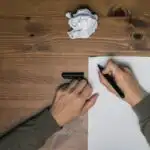Inventors are people who look at life and see new ways of doing things.

Some of them set out to improve existing systems, others find new ways to tackle old problems, and some simply change the way we approach the world!
To inspire your students to get creating, we’ve rounded up 45 incredible inventors that everyone should know about! Let’s get discovering!
1. Johannes Gutenberg
If it weren’t for Johannes Gutenberg, we might not have any textbooks! Gutenberg’s printing press allowed for mass-produced movable type and his invention soon spread across the world.
Thanks to the Gutenberg printing press, the written word became more accessible. Information could spread further, changing society forever!
2. Leonardo Da Vinci
Painter, theorist, scientist, and sculptor — what didn’t Leonardo da Vinci do? The epitome of a “Renaissance” man, da Vinci is best known for his paintings, but his intricate notebooks revealed the mind of an inventor.
Many of his most daring inventions weren’t feasible in his lifetime, but have influenced inventors in the centuries that followed.
3. Benjamin Franklin
As well as being one of the founders of the modern United States, Benjamin Franklin was a highly prolific inventor. Franklin was a man who liked to experiment!
He invented the lightning rod after much experimentation with electricity. The rod ensures that tall buildings are safe in a lightning storm.
4. Robert Fulton
From a very young age, Robert Fulton was interested in combining the steam engine with the old-fashioned boat. In 1807, his creation came to life!
The North River Steamboat was the first commercially successful steamboat in the world.
Fulton’s steamboat traveled 300 nautical miles along the Hudson River. By the time it returned to New York City, it had changed American trade forever.
5. Eli Whitney
Before Eli Whitney came along, cotton harvesting was a long and laborious process. His invention, the cotton gin, made everything run a lot quicker.
The cotton gin was able to quickly separate the seeds from the cotton fibers. These separated cotton fibers could then be used to make clothing and textiles, while the seeds could be used to grow more cotton.
6. Louis Daguerre
Artist and photographer Louis Daguerre was responsible for the creation of the Daguerreotype.
This early form of photography used a sheet of polished silver-plated copper that was treated with fumes and then exposed to light. It was a laborious process, but it did capture crisp and clear images.
7. Thomas Jennings
Thomas L. Jennings was the first ever African-American to hold a patent! He was granted this achievement in 1821 thanks to his innovative dry-cleaning process.
His invention made him a lot of money, which Jennings’ primarily invested into funding the U.S. Abolitionist movement.
8. Nancy Johnson
If you’ve ever enjoyed a refreshing ice cream on a warm day, you have Nancy Johnson to thank! She patented a hand-cranked ice cream freezer that made ice cream quicker and easier to make.
9. Louis Braille
Louis Braille always had a sharp and curious mind, but after an infection caused him to go blind in both eyes, he found the cumbersome tactile writing system slowed down his quest for knowledge.
Inspired by shorthand, he created Braille, a code that allowed blind people to read and write efficiently.
10. Margaret Knight
The flat-bottomed paper bag is one of those everyday objects that we take for granted.
But it wasn’t until Margaret Knight invented a machine that produced flat-bottomed paper bags in 1868 that they became commonplace.
Knight is responsible for many other helpful household inventions, such as a cooking spit and a window and sash.
11. Alexander Miles
Getting on an elevator is an everyday activity, but before Alexander Miles, it came with a high risk. Elevator doors had to be manually opened and closed.
If it wasn’t done properly, people could fall through. Miles’ elevator door mechanism closed doors automatically, making a trip in an elevator a much safer mode of transport.
12. Josephine Cochrane
No one ever looks forward to household chores, but Josephine Cochrane disliked washing the dishes so much that she decided to do something about it.
Her invention, the hand-powered dishwasher, was first marketed to hotels and businesses before becoming a desirable household accessory.
13. Alexander Graham Bell
Talking on the telephone is something that many of us do every day. But before Alexander Graham Bell, this kind of quick and easy communication wasn’t possible!
Bell is credited as the inventor of the first practical telephone — decades later, and now with a quick call your mom can find out just what’s going on when you’re home late.
14. Thomas Edison
A slow-burning carbon filament might not sound like the most exciting invention, but it’s thanks to this creation by Thomas Edison that we have the lightbulb!
And this isn’t the only Edison invention that we have in the home. If you enjoy watching movies or listening to music, you can thank Thomas Edison for the motion picture camera and the phonograph.
15. Lewis Howard Latimer
Lewis Howard Latimer is an inventor responsible for many everyday comforts. He developed an air conditioning unit, an improved bathroom for the train, and even improved the inside of the light bulb!
He also drafted the pictures that were used by Alexander Graham Bell to patent the telephone.
16. Nikola Tesla
Nikola Tesla was the inventor of Alternating Current (AC), a form of electrical current that flows in two directions.
Safer than Direct Current (DC) electricity, AC is what powers our homes. Tesla was a prolific inventor — he even created a radio remote control boat!
17. The Lumiere Brothers
Brothers Auguste and Louis Lumiere are the inventors of the cinematograph, a camera and projection device. They were also early pioneers of color photography.
So, next time you enjoy the latest superhero blockbuster, think about a 46-second film titled “Workers Leaving the Lumiere Factory”!
18. Henry Ford
Henry Ford’s name is almost synonymous with the car, and his Ford Model T revolutionized transportation.
He was also responsible for a revolution in manufacturing, as he was the chief developer of the assembly line, which made mass production a much easier process.
19. George Washington Carver
A prominent agricultural scientist, to most people, George Washington Carver is known for his work with peanuts! He came up with many uses for peanuts, prompting farmers to start growing the crop.
But it wasn’t a love of peanut butter that motivated Carver — by switching to peanut crops, he helped farmers avoid soil depletion.
20. Mary Anderson
Rainy weather can be a serious hazard when driving a car, which is why Mary Anderson decided to do something about it.
Her invention was a hand-operated device that could control rubber blades on the car window. It became the windshield wiper, and nearly all motor vehicles are fitted with an (updated) version today.
21. Madam C. J. Walker
The harsh chemicals Madam C. J. Walker had to use to wash were causing serious problems for her hair and skin.
To deal with the uncomfortable issue, she created a line of hair care and cosmetic products for black women. Immensely popular, the business made Walker the first female self-made millionaire.
22. Marie Curie
Marie Sklodowska Curie was a pioneering figure in the field of radioactivity and the technologies she created changed the face of cancer research.
As well as her research into radioactivity, Curie developed a mobile radiography unit and discovered two elements: polonium and radium.
23. The Wright Brothers
Brothers Orville and Wilbur Wright were pioneers of the aviation industry. They’re generally recognized as the inventors of the first motor-operated airplane, having made a controlled and sustained flight in 1903.
Imagine how much longer travel would take without the airplane? Even quick journeys across the country could take days.
24. Garrett Morgan
Like many great inventors, Garrett Morgan noticed a problem and sought to fix it. He saw that the “stop” and “go” road signals were leading to accidents and poor traffic flow.
His folding traffic signals could be used to indicate caution, reducing risk and saving lives.
25. John Logie Baird
Do your students love watching TV? Then they should take a moment to thank John Logie Baird, the Scottish inventor who demonstrated the first live working television system all the way back in 1926!
His first images were of a ventriloquist’s dummy, so we’re glad it’s evolved since then.
26. Frederick McKinley Jones
Frederick McKinley Jones received 61 patents throughout his career as an inventor. 40 of those patents were in the field of refrigeration technology.
His portable air-cooling technology helped trucks keep things from spoiling during transit. During WWII, this technology helped preserve blood and food, saving many lives.
27. Katharine Burr Blodgett
Katharine Burr Blodgett was a research scientist who pioneered a type of “invisible” glass.
By covering the glass in lots and lots of tiny layers reflections were canceled out, creating that “invisible” look. This clear glass was used on everything from automobiles to movie cameras.
28. Maria Telkes
Solar energy could be the future of our planet and it was pioneered by “The Sun Queen” Maria Telkes.
Her solar thermal storage systems could keep energy overnight, allowing power from the sun to be used when needed. She designed the first solar-heated house with architect Eleanor Raymond.
29. Ruth Wakefield
Can you imagine a world without chocolate chip cookies? That’s what life was like before 1938 when Ruth Wakefield thought of adding chocolate chips to a cookie dough mix!
Known as the Toll House cookie, the invention (unsurprisingly) proved to be incredibly popular.
30. Charles R. Drew
Charles R. Drew is an inventor responsible for saving many lives during WWII. He pioneered the development of a large-scale blood bank, allowing injured soldiers to receive the treatment they needed.
A prominent medical researcher, he also fought against racial discrimination in blood donations.
31. Grace Hopper
Nowadays, computers are small enough to fit in our pockets. But when Grace Hopper first started working with them, a computer took up an entire room!
She believed that computers were the future and became one of the earliest computer programmers, even inventing some of the first computer systems.
32. Hedy Lamarr
As well as a prolific actress in the Hollywood Golden Age, Hedy Lamarr was also a scientist and inventor.
During WWII, she developed a radio guidance system that helped keep torpedoes on track. The technology is still used in modern-day Wi-Fi and GPS systems.
33. George Nissen
While most inventors work for many, many years perfecting their creations, George Nissen hit on his big idea while very young.
At just 16, Nissen was inspired by circus performers to create the first-ever trampoline. He also helped develop the sport of trampoline gymnastics!
34. Ruth Handler
Barbie has run for president, been to space, won Olympic gold, and explored the oceans.
But when Ruth Handler created the first Barbie doll in 1959, she was a much simpler fashion doll designed to offer a different play experience for young girls.
35. Katsuko Saruhashi
The health of our seas is vital to the health of our planet, and it’s thanks to Katsuko Saruhashi that we better understand how the oceans are doing.
She created devices that allowed us to measure the level of carbon dioxide in seawater.
36. Marie Van Brittan Brown
A working nurse married to an electrician, irregular shift patterns meant Marie Van Brittan Brown was often alone in her house.
With the crime level rising and police response slow, Marie invented a way to help herself feel safe.
Consisting of 4 peepholes, a sliding camera, TV monitors, and microphones, this was the precursor to the modern home security system.
37. Stephanie Kwolek
Stephanie Kwolek was a chemist known for her work with synthetic fibers. The fiber she invented was super strong, super stiff, and flame-resistant.
Her work developed into high-strength Kevlar, which is used in everything from bike tires to bulletproof vests.
38. Peter Tsai
Peter Tsai’s invention, the N95 mask filter, came to global prominence in 2020 when it was used to help combat the spread of COVID-19.
An expert in nonwoven fabrics, his filtering respirator helped block dangerous airborne particles from entering the body.
39. Jerry Lawson
The “father of the video game cartridge”, Jerry Lawson helped the video game move from arcades and into our homes!
He led the development of the video console and game cartridge. By storing games on the cartridge, users could play multiple games with just one console.
40. Patricia Bath
Patricia Bath’s work in ophthalmology led her to create the Laserphaco Probe. This machine used lasers to easily and painlessly remove cataracts from the eye.
Her invention is used internationally to treat cataracts, saving the sight of people across the globe.
41. Jocelyn Bell Burnell
Whilst studying as a postgraduate student in astrophysics, Jocelyn Bell Burnell discovered the first radio pulsars.
In 1974, this discovery earned the Nobel Prize in Physics — but Bell Burnell was not among the recipients. It wasn’t until later in her career she finally got (some of) the recognition she deserved.
42. Shirley Jackson
Physicist, researcher, and inventor, Shirley Jackson’s work with fiber optics helped transform the communication industry.
She’s an undeniable leader in the field — Jackson was the first ever African-American woman to earn a doctorate at MIT.
43. Lonnie Johnson
Lonnie Johnson is an aerospace engineer who worked in both the U.S. Air Force and NASA, but he’s best known for an invention you’re likely to find in your backyard.
His experiments in the Jet Propulsion Laboratory led to the invention of the Super Soaker, and the water gun has been a top-selling toy ever since.
44. Ann Tsukamoto
Ann Tsukamoto’s research into stem cells has led to groundbreaking advancements in the understanding and treatment of cancer.
She co-patented a device that allowed the human stem cell to be isolated, allowing scientists to better research this essential building block of life.
45. Tim Berners-Lee
It’s thanks to Tim Berners-Lee that we have so many ways to learn about the great inventors of the past.
He is the inventor of the World Wide Web, so it’s thanks to him that we have access to the Internet (and all the wonderful things it contains)!
Conclusion
We hope this guide has helped you discover some of the best inventors from history. But this is just the tip of the iceberg!
Why not encourage the students to discover their own inspiring creator — or get to work on the next great invention?
- Homeschooling In High School: Pros And Cons - February 24, 2024
- How Do I Withdraw My Child From School To Homeschool? - February 23, 2024
- How To Not Go Crazy Homeschooling Kids: A Guide For Frazzled Parents - February 22, 2024









Leave a comment